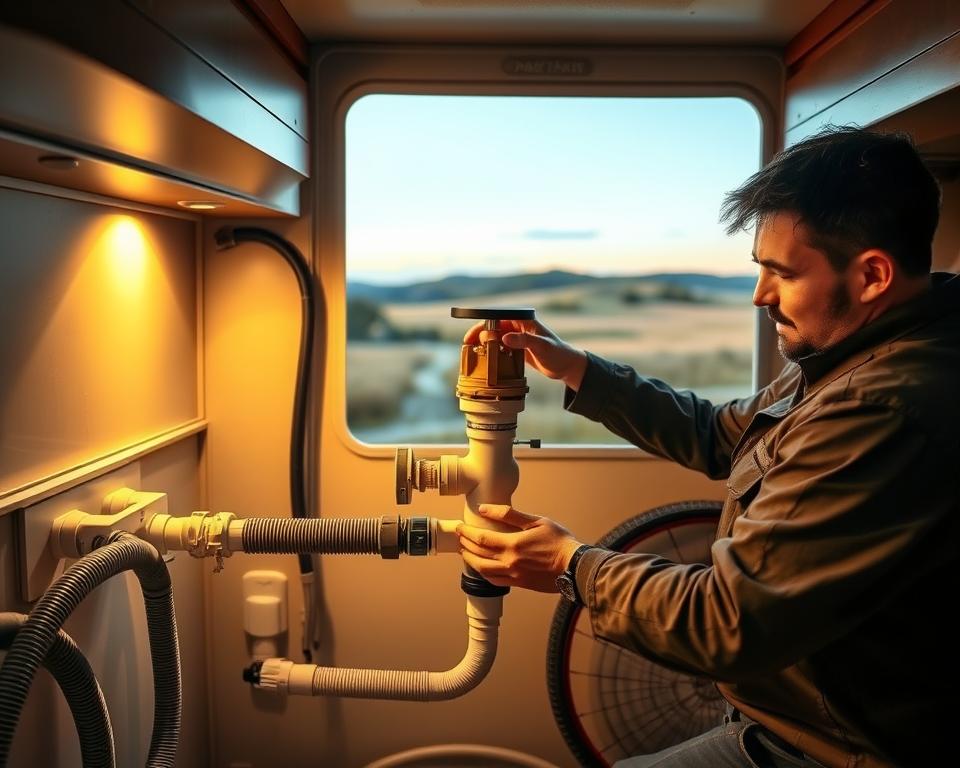Your RV Black Water Tank Pump: Guide and Maintenance Tips
Ever wondered about the impact of the RV black water tank pump on your RVing journey? A crucial aspect of your RV’s hygiene system is the black water tank pump. To ensure your travels are uninterrupted, proper maintenance is key. Inside, you’ll discover key information on how to manage your RV waste water pump. If you understand its importance, you can optimize its performance and have even better RV experiences.
Primary Highlights
- The RV black water tank pump plays a vital role in efficient waste disposal.
- The longevity of your RV waste water pump can be increased through regular maintenance.
- Familiarity with the system’s parts improves it easier to troubleshoot issues.
- Practicing safe dumping is important for both your health and the planet.
- Winter preparation of your RV black water tank system helps avoid expensive fixes.
- A clean RV sanitation pump helps prevent blockages and bad smells.
The Importance of Understanding RV Water Tanks
For trouble-free camping with RV septic tank pumping, it’s possible that many RV owners don’t fully realize the significance of various water tanks. The functions of the RV fresh water, gray water, and black water tanks are important to be aware of. Each plays a unique role and needs proper care.
Drinkable water is stored in the RV fresh water tank. It’s used for drinking, cooking, and hygiene. Ensuring this tank’s cleanliness and water safety is paramount. Fresh water is crucial for hydration and health during travels.
The wastewater from sinks and showers is collected in the RV gray water tank. Frequent checks and draining are necessary because this tank can fill up quickly. Proper gray water tank management is essential for a clean RV living space.
The RV black water tank is critical, holding toilet waste. You need to keep a close eye on it to prevent odors and accumulation. Applying the proper tank chemicals will improve the tank’s condition and your RVing experience. Knowing how to care for each tank makes RV trips more enjoyable.
What is the RV Black Water Tank Pump?
Recreational vehicle sanitation systems rely heavily on the RV black water tank pump. Waste is transported by this pump to designated places for disposal. Knowing how it works is key for maintenance and avoiding expensive fixes.
Owners of RVs have a selection of pump types to choose from, including the sewer pump. Due to its ability to grind waste and thus make disposal quicker, the macerator pump is a popular choice. This is particularly useful when dump stations are crowded.
Waste management in an RV depends on having a quality black tank pump. By using it, your RV will stay clean and comfortable. Regular checks and understanding how your pump functions will help you optimize your RV experience.
The Essential Components of a Black Water Tank System
To manage waste effectively, you need to understand the RV black water tank system. Many important parts are involved, and they work together to make sure everything runs smoothly. Holding the waste from the RV’s toilet, the black water tank is the most important part. Constructed from strong materials, it’s built to withstand different conditions.

A significant function of the system’s pump is to move waste to a designated disposal area. It is indispensable for RV owners. Sewer hoses are also crucial, as they provide a flexible connection from the tank to the dump station. Made to prevent leaks and keep odors contained, these hoses ensure a clean way to dispose of waste.
Connection ports are vital for attaching sewer hoses, which helps in the effective transfer of waste. Controlling the flow of waste is the crucial role of termination valves. To maintain sanitation, they prevent waste from flowing back and stop spills during disposal.
Knowing about these essential parts helps RV owners keep their sanitation system running well. Knowing this is crucial for fixing problems while traveling or using the RV, which makes better the whole RV experience.
Guidelines for Proper RV Black Water Tank Pump Usage
Learning to use the RV sanitation pump effectively will profoundly improve your RV living. Knowing how to operate the black tank properly is vital for a smooth-running system. Thoroughly flushing the tank after each use is a vital step. This practice helps avoid the buildup of solid waste, which might result in blockages and other issues.
Checking your RV sanitation pump regularly makes sure it’s working the way it should. By doing this, you can prevent any unpleasant issues while you’re on the road. Using toilet paper that is designed for RVs is also very important. Designed to disintegrate quickly, this type of toilet paper helps in reducing the risk of clogs.
Keeping the termination valves closed, except during emptying, is another vital practice. This helps prevent bad smells. Also, adding tank deodorants and cleaners will help the system smell nice and stay clean. Adhering to these guidelines improves your experience with the RV black water tank.
| How to Properly Use Your Black Tank | Upsides |
|---|---|
| Flush with Plenty of Water | Prevents solid waste clogs |
| Make Sure to Regularly Check How the Pump Works | Ensures it functions effectively |
| Use RV-Specific Toilet Paper | Reduces risk of blockages |
| Ensure the Termination Valves Remain Closed | Lowers the amount of odor |
| Using Tank Deodorants and Cleaning Agents | Ensures the system remains hygienic and without odors |
Essential Maintenance Tips for the Black Water Tank Pump
It’s vital to maintain your RV’s black water tank pump regularly so it lasts longer and works efficiently. This means you need to use the correct chemical treatments that are designed for these types of tanks. They work well to dissolve waste and prevent odors from forming.
Making sure there’s enough water when you use the toilet is also very important. It allows waste to flow easily into the tank, thus reducing the possibility of buildup. Additionally, don’t forget to regularly deep clean the tank and its components. Use the recommended tools for this important task.
Keep an eye on the tank levels at all times to prevent problems. Address leaks or overflows without delay. Make sure to empty the tank regularly to prevent solid waste accumulation. A maintenance schedule can help you avoid problems with your RV experience.
| Job for Maintenance | Timing | What to Do |
|---|---|---|
| Check levels | On every journey | Don’t let the tank get too full, as this can cause leaks. |
| Use chemicals | Once you’ve dumped | Use treatments to help break down waste well. |
| Perform a system flush | Once a month | Apply a cleaning solution to help keep the tank clean. |
| Look over the pump | Before any long travel | Make sure there’s no wear and tear to prevent the pump from breaking down while you’re traveling. |
| Dispose of tank contents | When required | It’s best to empty the tank at designated dump stations when it reaches full capacity. |
Following these key maintenance practices will ensure your black water tank pump works well. This will enhance your RV trips significantly.
How to Troubleshoot Common Black Water Tank Pump Issues
Fixing problems with the black tank pump can appear challenging. A lot of RV owners experience different problems with their RV black tanks, like clogs, leaks, or smells that won’t go away. Dealing with these challenges early can help you save time and money on fixes.
Start by inspecting the hoses connected to the black tank pump. It’s common for blockages to occur in these hoses, resulting in the pump not working properly. Take the hoses off and see if there’s any buildup or dirt inside. If you find any blockages, make sure to clean the hoses completely before putting them back on.
Following that, examine the seals surrounding the pump and the tank. Damaged seals can result in leaks that may go unnoticed until significant damage has occurred. Replace any faulty seals immediately to prevent further issues.
If you’re dealing with odors that just won’t disappear, enzyme treatments might be useful. These treatments help to dissolve waste and get rid of bad smells. Make sure to follow the manufacturer’s instructions for optimal results.
Here is a quick reference table summarizing common issues and their solutions:
| Problem | Possible Cause | Solution |
|---|---|---|
| Build-up | Something stuck in the hoses or tank | Make sure to check and clean the hoses |
| Loss of liquid | Seals that are not working properly | Check the seals and replace them if needed |
| Foul smells | Waste that has accumulated | Apply enzyme treatments |
| Pump isn’t functioning | Problems with the power | Make sure the connections are good and check the battery |
If you notice the early signs of a problem, you can stop it from becoming a serious issue with your RV black tank. Regular maintenance and vigilance will improve the longevity of your black tank pump, enhancing your RV experience.
How to Clean Your RV Black Water Tank Pump
For good hygiene and to keep your RV’s plumbing working well, it’s important to keep the black water tank clean. Aim to minimize odors and ensure everything functions smoothly by rinsing with fresh water after use. This reduces waste buildup and maintains the tank’s condition.
For a more thorough cleaning, use cleaning solutions that are made for black water systems. These agents dissolve waste and combat odors effectively. Fill up the tank with water and the cleaning solution, and then let it sit for a while. If your RV has a flush system that’s built in, it will make cleaning easier.
When driving, sharp turns or sloshing techniques can agitate the tank’s contents. This action helps to loosen any remaining waste that’s stuck to the tank walls. Cleaning in this way helps the sensors be more accurate, which can help you avoid sewage problems.
Ensuring Safe Dumping Procedures at RV Stations
Knowing the proper way to behave at RV dump stations is important so that everyone can use them comfortably. Upon reaching a station, make sure your RV is positioned correctly. Then, get your gear ready for dumping.
Follow these steps carefully to make sure the process goes well:
- Ensure a firm connection between your sewer hose and the station’s outlet.
- Open the black water valve first to let the sewage drain out.
- After the black tank empties, close its valve. Then, open the gray water valve to clean the hose with the less dirty water.
- Once done, carefully remove your hose to prevent any spills.
- Always clean your hoses with safe-to-drink water and put them away right after.
You must also follow the local regulations for waste disposal. To protect the environment, many areas have rules that you are required to follow. Not following these can result in fines or other consequences.
Showing respect at RV dump stations helps make the experience better for all. If you keep the area clean and follow the rules, you’re showing that you care about the community. Such actions foster a culture of responsibility among RV enthusiasts and encourage eco-friendly camping habits.
Winterizing Your RV Black Water Tank System
Winterizing your RV tanks is essential to keep the black water system safe from freezing. It’s crucial to prepare your system properly to avoid damage from water that freezes inside. To make sure your RV black tank is effectively cared for in the winter, you need to follow specific steps.
- Begin by completely emptying the black water tank using the correct pump and connections.
- Following that, bypass the water heater to stop water from getting in and building up in the unit.
- Make sure to use antifreeze that is made for RVs, because regular antifreeze can be poisonous and bad for the environment. Pour the antifreeze into the system according to the product instructions.
- Ensure all faucets and drains are left open to allow any residual water to escape and for the antifreeze to circulate.
- Finally, ensure that all access panels are properly sealed and secured to prevent water from entering during the winter.
By taking these winterization steps, RV owners protect their black water tank systems from harsh winter impacts. This proactive approach helps to avoid expensive repairs or maintenance when the seasons change.
Wrapping It Up
If you want to be a successful RV owner, you need to make sure you maintain your RV black water tank efficiently. Learning how to use the black water tank pump properly and following the maintenance advice in this guide will make your trips more enjoyable. Proper care extends the life of your gear and simplifies RV waste management. This makes travel less daunting.
Knowledge about your RV’s black water system is key to handling issues head-on. Using proper maintenance, troubleshooting, and cleaning methods helps to prevent unexpected issues. This lets you enjoy worry-free road trips. Working with reputable services like All in Sanitation can bolster your maintenance efforts. You can get the essential products and support for top-quality care from them.
To be a good RV owner, you need to be attentive and take proper care of all parts of your vehicle, including the black water tank. Now that you know this, you’re all set to explore freely. You’ve made all the correct decisions to guarantee a wonderful journey for yourself and those with you.


